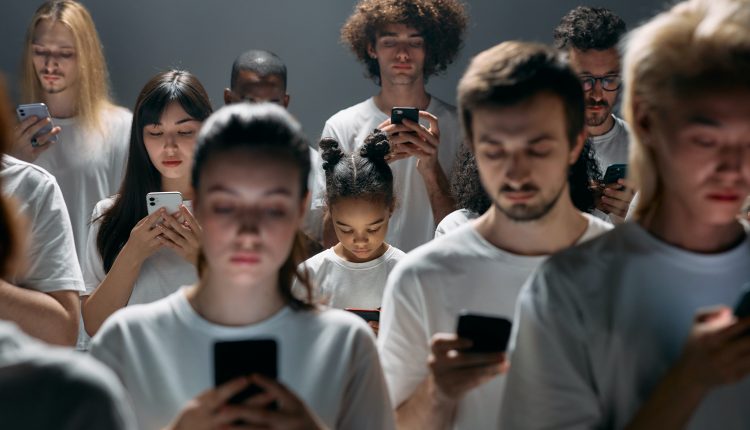
Nomophobia, an unrecognised mental disorder: smartphone addiction
Nomophobia has not been officially recognised as a disorder by the Diagnostic and Statistical Manual of Mental Disorders (DSM-5, A proposal for including nomophobia in the new DSM-V, Nicola Luigi Bragazzi, and Giovanni Del Puente, published online May 2014). However, this phobia can be framed as a specific situational phobia, depending on symptoms and presentation
Nomophobia or ‘NO Mobile Phone PhoBIA’ is also called disconnection syndrome.
It describes the fear of being disconnected/offline/removed from a technological device (smartphone, tablet, iPhone, PC, Notebook).
People with this syndrome seek constant and exaggerated contact with the technological device, which gives them the feeling of being in constant control of the situation.
The reasons for this can be traced back to the sense of security provided by being contactable at all times and the work requirements of someone who has to be on call practically 24 hours a day.
The risk of a mere pathological dependency in which one cannot do without an internet connection and a mobile phone and the fear of being disconnected can lead to experiences of anxiety and depression.
Very often, even the mere idea of being without a smartphone or technological connection device can generate malaise, restlessness and aggression.
These feelings can also be associated with suicidal ideation and/or behaviour.
The term No Mobile Phone PhoBIA was first coined in England in 2008, during a study commissioned by the British government to investigate the correlation between the development of anxiety spectrum disorders and the overuse of mobile phones.
The study identified that about 53% of Britons who used mobile phones experienced high levels of apprehension and anxiety when they ‘lost their mobile phones, their mobile phones ran out of power, ran out of credit to call or text, or had no signal coverage’.
The study further revealed that approximately 58% of men and 47% of women were affected by disconnection anxiety with their mobile phone (NOMOPHOBIA: NO MOBILE PHONE PhoBIA Sudip Bhattacharya, Md Abu Bashar, Abhay Srivastava, and Amarjeet Singh, 2019).
It still remains controversial to what extent Nomophobia may be in any way facilitated or influenced by the presence of specific psychological variables and/or personological dimensions
Numerous studies have explored such variables, finding both the presence of high levels of extroversion and neuroticism, as well as low levels of self-esteem, high levels of impulsivity associated with high levels of anxiety.
It is becoming increasingly difficult to differentiate between a person who becomes nomophobic as a result of smartphone addiction, and a person who develops nomophobia as a consequence (precipitating factor) of the co-presence of an anxiety disorder.
Yet the emergence of the problem is assuming worrying proportions, worldwide.
NOMOPHOBIA, THE ALARM BELLS
- Regular use of a mobile phone and spending a lot of time on it
- Always have one or more devices and a charger with you to avoid running out of battery power
- Always keep your credit in good standing
- Experiencing anxiety and nervousness at the thought of losing your handset or when your mobile phone is unavailable or unusable
- Constantly monitoring the phone’s screen, to see if messages or calls have been received, or the battery, to check if the phone is running low;
- Keeping the mobile phone switched on at all times
- Going to bed with your phone or tablet in bed
- Using the smartphone in irrelevant places
These are among the psychological and behavioural characteristics that distinguish addiction from thoughtful, controlled smartphone use.
SYMPTOMS OF NOMOPHOBIA
– Anxiety
– Alterations in respiratory function
– Profuse sweating
– Agitation
– Disorientation
– Tachycardia
– Tremor
These are among the symptoms observed in a person suffering from nomophobia.
We specify that the most affected people are those belonging to the child and adolescent group (Prevalence of Mobile Phone Dependence in Secondary School Adolescents, Chimatapu Sri Nikhita, Pradeep R Jadhav, Shaunak A Ajinkya, Epub nov 2015).
TREATMENT
In some cases the treatment of Nomophobia is still very limited.
In some people psychological therapy is combined with psychopharmacological therapy.
It remains clear that for those suffering from Nomophobia, it becomes essential to re-establish contact with the real world, re-establish real-life interpersonal interactions, and connections “vis à vis” (Reality Approach or Reality Therapy).
It is very important to engage in practical and concrete activities such as painting, gardening, playing outdoors, all of which can distract the nomophobic person from using the smartphone.
Recent studies published on the phenomenon:
Bhattacharya S, Bashar MA, Srivastava A, Singh A.
NOMOPHOBIA: NO MOBILE PHONE PhoBIA
Bragazzi NL, King TS, Zerbetto R.
The Relationship Between Nomophobia and Maladaptive Coping Styles in a Sample of Italian Young Adults: Insights and Implications From a Cross-Sectional Study
Olivencia-Carrión MA, Ferri-García R, Rueda MDM, Jiménez-Torres MG, López-Torrecillas F.
Temperament and characteristics related to nomophobia
Article written by Dr Letizia Ciabattoni
Read Also:
The Panic Attack And Its Characteristics
Psychosis Is Not Psychopathy: Differences In Symptoms, Diagnosis And Treatment
Management Of Mental Disorders In Italy: What Are ASOs And TSOs, And How Do Responders Act?
Yale Medicine: Why Telehealth For Mental Health Care Is Working
Sources:
https://www.treccani.it/vocabolario/nomofobia_%28Neologismi%29/
https://www.dipendenze.com/nomofobia/
https://neomesia.com/nomofobia,-cos%C3%A8-e-perch%C3%A8-%C3%A8-allarme/
https://www.ncbi.nlm.nih.gov/pmc/articles/PMC4036142/https://pubmed.ncbi.nlm.nih.gov/15738692/


